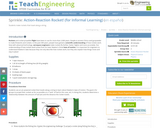
Students make rockets that travel along a string.
- Subject:
- Engineering and Information Technologies
- Material Type:
- Lesson Plan
- Provider:
- TeachEngineering
- Provider Set:
- TeachEngineering
- Date Added:
- 10/14/2015

Students make rockets that travel along a string.

Students compare and contrast passive and active transport by playing a game to model this phenomenon. Movement through cell membranes is also modeled, as well as the structure and movement typical of the fluid mosaic model of the cell membrane. Concentration gradient, sizes, shapes and polarity of molecules determine the method of movement through cell membranes. This activity is associated with the Test your Mettle phase of the legacy cycle.
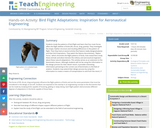
This activity first asks the students to study the patterns of bird flight and understand that four main forces affect the flight abilities of a bird. They will study the shape, feather structure, and resulting differences in the pattern of flight. They will then look at several articles that feature newly designed planes and the birds that they are modeled after. The final component of this activity is to watch the Nature documentary, "Raptor Force" which chronicles the flight patterns of birds, how researchers study these animals, and what interests our military and aeronautical engineers about these natural adaptations. This activity serves as an extension to the biomimetics lesson. Although students will not be using this information in the design process for their desert resort, it provides interesting information pertaining to the current use of biomimetics in the field of aviation. Students may extend their design process by using this information to create a means of transportation to and from the resort if they chose to.
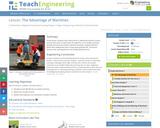
In this lesson, students learn about work as defined by physical science and see that work is made easier through the use of simple machines. Already encountering simple machines everyday, students will be alerted to their widespread uses in everyday life. This lesson serves as the starting point for the Simple Machines Unit.

In this unit, students learn about the form and function of the human heart through lecture, research and dissection. Following the steps of the Legacy Cycle, students brainstorm, research, design and present viable solutions to various heart conditions as presented through a unit challenge. Additionally, students study how heart valves work and investigate how faulty valves can be replaced with new ones through advancements in engineering and technology. This unit demonstrates to students how and why the heart is such a powerful organ in our bodies
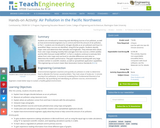
Students are introduced to measuring and identifying sources of air pollution, as well as how environmental engineers try to control and limit the amount of air pollution. In Part 1, students are introduced to nitrogen dioxide as an air pollutant and how it is quantified. Major sources are identified, using EPA bar graphs. Students identify major cities and determine their latitudes and longitudes. They estimate NO2 values from color maps showing monthly NO2 averages from two sources: a NASA satellite and the WSU forecast model AIRPACT. In Part 2, students continue to estimate NO2 values from color maps and use Excel to calculate differences and ratios to determine the model's performance. They gain experience working with very large numbers written in scientific notation, as well as spreadsheet application capabilities.
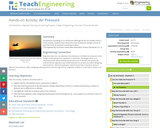
Air pressure is pushing on us all the time although we do not usually notice it. In this activity, students learn about the units of pressure and get a sense of just how much air pressure is pushing on them.
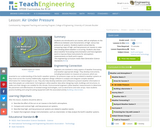
Students are introduced to air masses, with an emphasis on the differences between and characteristics of high- versus low-pressure air systems. Students also hear about weather forecasting instrumentation and how engineers work to improve these instruments for atmospheric measurements on Earth and in space.

Students learn what causes air pollution and how to investigate the different pollutants that exist, such as toxic gases and particulate matter. They investigate the technologies developed by engineers to reduce air pollution.
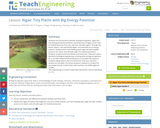
Students are introduced to biofuels, biological engineers, algae and how they grow (photosynthesis), and what parts of algae can be used for biofuel (biomass from oils, starches, cell wall sugars). Through this lesson, plants—and specifically algae—are presented as an energy solution. Students learn that breaking apart algal cell walls enables access to oil, starch, and cell wall sugars for biofuel production. Students compare/contrast biofuels and fossil fuels. They learn about the field of biological engineering, including what biological engineers do. A 20-slide PowerPoint® presentation is provided that supports students taking notes in the Cornell format. Short pre- and post-quizzes are provided. This lesson prepares students to conduct the associated activity in which they make and then eat edible algal cell models.
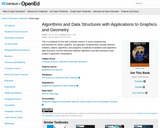
This is a textbook for first year Computer Science. Algorithms and Data Structures With Applications to Graphics and Geometry.
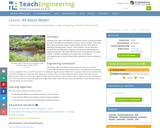
Students learn about the differences between types of water (surface and ground), as well as the differences between streams, rivers and lakes. Then, they learn about dissolved organic matter (DOM), and the role it plays in identifying drinking water sources. Finally, students are introduced to conventional drinking water treatment processes.
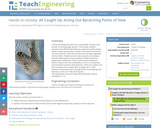
Commercial fishing nets often trap "unprofitable" animals in the process of catching target species. In this activity, students experience the difficulty that fishermen experience while trying to isolate a target species when a variety of sea animals are found in the area of interest. Then the class discusses the large magnitude of this problem. Students practice data acquisition and analysis skills by collecting data and processing it to deduce trends on target species distribution. They conclude by discussing how bycatch impacts their lives and whether or not it is an important environmental issue that needs attention. As an extension, students use their creativity and innovative skills to design nets or other methods, theoretically and/or through hands-on prototyping, that fisherman could use to help avoid bycatch.
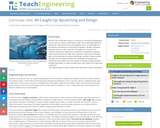
Bycatch, the unintended capture of animals in commercial fishing gear, is a hot topic in marine conservation today. The surprisingly high level of bycatch about 25% of the entire global catch is responsible for the decline of hundreds of thousands of dolphins, whales, porpoises, seabirds and sea turtles each year. Through this curricular unit, students analyze the significance of bycatch in the global ecosystem and propose solutions to help reduce bycatch. They become familiar with current attempts to reduce the fishing mortality of these animals. Through the associated activities, the challenges faced today are reinforced and students are stimulated to brainstorm about possible engineering designs or policy changes that could reduce the magnitude of bycatch.
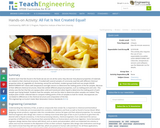
Students learn that fats found in the foods we eat are not all the same; they discover that physical properties of materials are related to their chemical structures. Provided with several samples of commonly used fats with different chemical properties (olive oil, vegetable oil, shortening, animal fat and butter), student groups build and use simple LEGO MINDSTORMS(TM) NXT robots with temperature and light sensors to determine the melting points of the fat samples. Because of their different chemical structures, these fats exhibit different physical properties, such as melting point and color. This activity uses the fact that fats are opaque when solid and translucent when liquid to determine the melting point of each sample upon being heated. Students heat the samples, and use the robot to determine when samples are melted. They analyze plots of their collected data to compare melting points of the oil samples to look for trends. Discrepancies are correlated to differences in the chemical structure and composition of the fats.
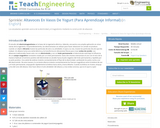
Los estudiantes aprenden acerca de la electricidad y el magnetismo mediante la construcción de altavoces
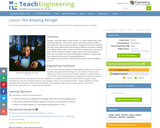
Aerogel, commonly called "frozen smoke," is a super-material with some amazing properties. In this lesson and its associated activity, students learn about this silicon-based solid with a sponge-like structure. Students also learn about density and how aerogel is 99.8% air by volume, making it the lightest solid known to humans! Further, students learn about basic heat transfer and how aerogel is a great thermal insulator, having 39 times more insulation than the best fiberglass insulation. Students also learn about the wide array of aerogel applications.
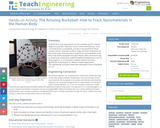
Students learn how nanoparticles can be creatively used for medical diagnostic purposes. They learn about buckminsterfullerenes, more commonly known as buckyballs, and about the potential for these complex carbon molecules to deliver drugs and other treatments into the human body. They brainstorm methods to track buckyballs in the body, then build a buckyball from pipe cleaners with a fluorescent tag to model how nanoparticles might be labeled and detected for use in a living organism. As an extension, students research and select appropriate radioisotopes for different medical applications.
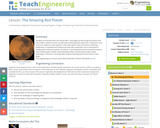
The purpose of this lesson is to introduce students to the planet Mars. This lesson will begin by discussing the location and size of Mars relative to Earth, as well as introduce many interesting facts about this red planet. Next, the history of Martian exploration is reviewed and students discover why scientists are so interested in studying this mysterious planet. The lesson concludes with students learning about future plans to visit Mars.
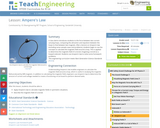
The lesson begins with a demonstration introducing students to the force between two current carrying loops, comparing the attraction and repulsion between the loops to that between two magnets. After formal lecture on Ampere's law, students begin to use the concepts to calculate the magnetic field around a loop. This is applied to determine the magnetic field of a toroid, imagining a toroid as a looped solenoid.